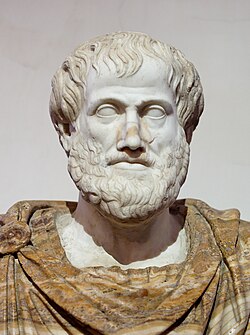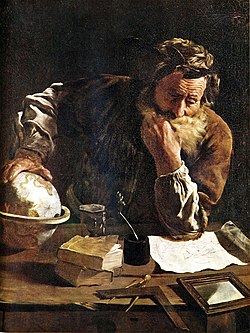Greek concept
The modit]ve towards a rational understanding of nature began at least since the Archaic period in Greece (650–480 BCE) with the Pre-Socratic philosophers. The philosopher Thales of Miletus (7th and 6th centuries BCE), dubbed "the Father of Science" for refusing to accept various supernatural, religious or mythological explanations for natural phenomena, proclaimed that every event had a natural cause.[1] Thales also made advancements in 580 BCE by suggesting that water is the basic element, experimenting with the attraction between magnets and rubbed amber and formulating the first recorded cosmologies. Anaximander, developer of a proto-evolutionary theory, disputed Thales' ideas and proposed that rather than water, a substance called apeiron was the building block of all matter. Around 500 BCE, Heraclitus proposed that the only basic law governing the Universe was the principle of change and that nothing remains in the same state indefinitely. He, along with his contemporary Parmenides were among the first scholars to contemplate on the role of time in the universe, a key concept that is still an issue in modern physics.

During the classical period in Greece (6th, 5th and 4th centuries BCE) and in Hellenistic times, natural philosophy developed into a field of study. Aristotle (Greek: Ἀριστοτέλης, Aristotélēs) (384–322 BCE), a student of Plato, promoted the concept that observation of physical phenomena could ultimately lead to the discovery of the natural laws governing them.[citation needed] Aristotle's writings cover physics, metaphysics, poetry, theater, music, logic, rhetoric, linguistics, politics, government, ethics, biology and zoology. He wrote the first work which refers to that line of study as "Physics" – in the 4th century BCE, Aristotle founded the system known as Aristotelian physics. He attempted to explain ideas such as motion (and gravity) with the theory of four elements. Aristotle believed that all matter was made of aether, or some combination of four elements: earth, water, air, and fire. According to Aristotle, these four terrestrial elements are capable of inter-transformation and move toward their natural place, so a stone falls downward toward the center of the cosmos, but flames rise upward toward the circumference. Eventually, Aristotelian physics became popular for many centuries in Europe, informing the scientific and scholastic developments of the Middle Ages. It remained the mainstream scientific paradigm in Europe until the time of Galileo Galilei and Isaac Newton.
Early in Classical Greece, knowledge that the Earth is spherical ("round") was common. Around 240 BCE, as the result of a seminal experiment, Eratosthenes (276–194 BCE) accurately estimated its circumference. In contrast to Aristotle's geocentric views, Aristarchus of Samos (Greek: Ἀρίσταρχος; c. 310 – c. 230 BCE) presented an explicit argument for a heliocentric model of the Solar System, i.e. for placing the Sun, not the Earth, at its centre. Seleucus of Seleucia, a follower of Aristarchus' heliocentric theory, stated that the Earth rotated around its own axis, which, in turn, revolved around the Sun. Though the arguments he used were lost, Plutarch stated that Seleucus was the first to prove the heliocentric system through reasoning.

In the 3rd century BCE, the Greek mathematician Archimedes of Syracuse Greek: Ἀρχιμήδης (287–212 BCE) – generally considered to be the greatest mathematician of antiquity and one of the greatest of all time – laid the foundations of hydrostatics, statics and calculated the underlying mathematics of the lever. A scientist of classical antiquity, Archimedes also developed elaborate systems of pulleys to move large objects with a minimum of effort. The Archimedes' screw underpins modern hydroengineering, and his machines of war helped to hold back the armies of Rome in the First Punic War. Archimedes even tore apart the arguments of Aristotle and his metaphysics, pointing out that it was impossible to separate mathematics and nature and proved it by converting mathematical theories into practical inventions. Furthermore, in his work On Floating Bodies, around 250 BCE, Archimedes developed the law of buoyancy, also known as Archimedes' principle. In mathematics, Archimedes used the method of exhaustion to calculate the area under the arc of a parabola with the summation of an infinite series, and gave a remarkably accurate approximation of pi. He also defined the spiral bearing his name, formulae for the volumes of surfaces of revolution and an ingenious system for expressing very large numbers. He also developed the principles of equilibrium states and centers of gravity, ideas that would influence future scholars like Galileo, and Newton.
Hipparchus (190–120 BCE), focusing on astronomy and mathematics, used sophisticated geometrical techniques to map the motion of the stars and planets, even predicting the times that Solar eclipses would happen. He added calculations of the distance of the Sun and Moon from the Earth, based upon his improvements to the observational instruments used at that time. Another of the early physicists was Ptolemy (90–168 CE) during the time of the Roman Empire. Ptolemy was the author of several scientific treatises, at least three of which were of continuing importance to later Islamic and European science. The first is the astronomical treatise now known as the Almagest (in Greek, Ἡ Μεγάλη Σύνταξις, "The Great Treatise", originally Μαθηματικὴ Σύνταξις, "Mathematical Treatise"). The second is the Geography, which is a thorough discussion of the geographic knowledge of the Greco-Roman world.
Much of the accumulated knowledge of the ancient world was lost. Even of the works of the many respectable thinkers, few fragments survive. Although he wrote at least fourteen books, almost nothing of Hipparchus' direct work survived. Of the 150 reputed Aristotelian works, only 30 exist, and some of those are "little more than lecture notes".
Комментариев нет:
Отправить комментарий